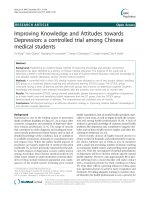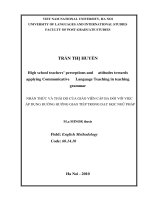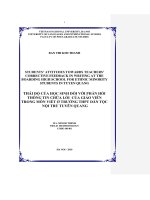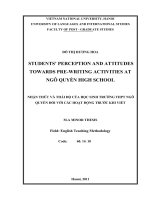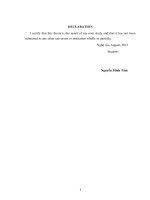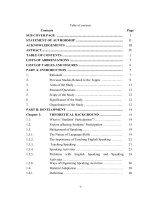employment and attitudes towards schema building activities in esp reading comprehension
Bạn đang xem bản rút gọn của tài liệu. Xem và tải ngay bản đầy đủ của tài liệu tại đây (2.15 MB, 223 trang )
MINISTRY OF EDUCATION AND TRAINING
HO CHI MINH CITY OPEN UNIVERSITY
-----------------------------------------
EMPLOYMENT AND ATTITUDES
TOWARDS SCHEMA-BUILDING ACTIVITIES
IN ESP READING COMPREHENSION
A THESIS SUBMITTED IN PARTIAL FULFILLMENT OF THE REQUIREMENTS
FOR THE DEGREE OF MASTER OF ARTS (TESOL)
Submitted by LE THI KIM TRUOC
Supervisor: Assoc. Prof. Dr. PHAM VU PHI HO
Ho Chi Minh City, April 2017
STATEMENT OF AUTHORSHIP
I certify that this thesis entitled “Employment and Attitudes towards Schemabuilding Activities in ESP Reading Comprehension” is my own work.
Except where reference is made in the text of the thesis, this thesis contains no
material published elsewhere or extracted in whole or in part from a thesis by which I have
qualified for or been awarded another degree or diploma.
No other person‟s work has been used without due acknowledgement in the main
text of the thesis.
This thesis has not been submitted for the award of any degree or diploma in any
other tertiary institution.
Ho Chi Minh City, 2017
Le Thi Kim Truoc
i
ACKNOWLEDGEMENTS
This thesis is the report of a research that could not have been accomplished without
the help and support of many people.
First and foremost, I would like to express my sincere appreciation and deep
gratitude to my supervisor, Assoc. Prof. Dr. Pham Vu Phi Ho, for his advice, critical
questions, valuable suggestions, detailed comments, hands-on experience, and for always
having an open door. His enthusiasm and great care will always be remembered.
Second, special thanks are also forwarded to Ph.D. Luu Trong Tuan who taught me
the research methodology subject and gave me useful comments in the early stage of
choosing this research topic. Besides, I am very grateful to all of my teachers who have
taught and guided me with useful knowledge and experiences during the M.A. course.
Third, I would like to extend my appreciation to the Dean of FFL-HCMUTE– Ph.D.
Dang Tan Tin, the Vice-Dean of FFL-HCMUTE–M.A. Le Phuong Anh, and the Head of
ESP Department–M.A. Le Thi Thanh Ha, M.A. Pham Van Khanh, M.A. Dang Ba Ngoan,
M.A. Tran Thi Thien Thanh for their permission and support during the data collection
process.
Fourth, I am deeply indebted to all ESP teacher participants and the student
participants at FFL-HCMUTE who have been willing to fulfill the study‟s questionnaires
and involved in the interviews. This thesis would not be possible without their kindness
and willingness.
Fifth, a big thank you goes to my friends M.A. Le Thi Kim Thu, M.A. Pham Van
Khanh, M.A. Nguyen Thi Tham, M.A. candidate Nguyen Thi Tuyet, and M.A. Truong
Minh Hoa for their valued friendship as well as for their support, assistance, comments,
proofreading, and encouragement throughout the study.
ii
Finally, I would like to express my greatest love and gratitude to my beloved mother
in heaven who inspired me to take this M.A. course, my beloved father who always give
me love and care, my three cousins whose own pursuit of an M.A. degree demonstrated to
me that I also could attain such achievements someday. In addition, I warmly thank my big
family, my roommates, and my closed friends who always support and encourage me in
doing this research. My dream of fulfilling this academic goal in life would have been
impossible without my beloved people.
iii
ABSTRACT
This study aims at investigating the extent to which pre-reading schema-building
activities (Pre-SBAs) are applied in teaching ESP (English for Specific Purposes) reading
comprehension for English majors as well as the learners‟ and teachers‟ attitudes towards
these applications at Faculty of Foreign Languages – Ho Chi Minh City University of
Technology and Education (FFL-HCMUTE). To do this, a survey method was designed
with survey questionnaires and semi-structured interviews employed as measure
instruments. The participants included 118 English majors and 4 ENEE teachers for the
questionnaire surveys and 12 English majors and 2 ENEE teachers for the interviews. After
all data were collected, they were coded in Excel, analyzed Mean (M), Standard Deviation
(SD), and percentage in SPSS version 22, descriptively interpreted, and discussed. The
findings indicate that various Pre-SBAs have been frequently implemented in teaching
ENEE reading comprehension, the previewing and pre-questioning were used more
“often” than brainstorming activities; both learners and teachers possessed a positive
attitude towards the applications. Specifically, for learners, a majority of them positively
believed, thought, and behaved in ENEE reading classes. For teachers, most of them also
acknowledged the usefulness of Pre-SBAs in learners‟ reading comprehension and thought
that these activities could inspire learners to engage in the class. However, the positive
levels which were not really high uncover that the application was not remarkably
effective, so learners still had difficulties in comprehend the ENEE texts. Although the
emerging findings reveal that there was no significant difference between learners‟ and
teachers‟ attitudes towards the implementation in ENEE reading comprehension, there was
a tendency that the ENEE teachers overestimated the effectiveness of the methods on
learners‟ thinking and feelings while they were unaware of learners‟ behaviors in whileand post-reading stage. Based on these findings, the study ended with some implications
for improvements and suggestions for further research.
iv
TABLE OF CONTENTS
STATEMENT OF AUTHORSHIP ........................................................................................ i
ACKNOWLEDGEMENTS ................................................................................................... ii
ABSTRACT.......................................................................................................................... iv
TABLE OF CONTENTS....................................................................................................... v
LIST OF TABLES ................................................................................................................. x
LIST OF FIGURES .............................................................................................................. xi
LIST OF ABREVIATIONS AND SYMBOLS ...................................................................xii
Chapter 1: INTRODUCTION ............................................................................................... 1
1.1. Background of the study ............................................................................................. 1
1.2. Statement of the Problem ............................................................................................ 3
1.3. Research questions ...................................................................................................... 6
1.4. Significance of the study ............................................................................................. 6
1.5. Overview of thesis chapters ........................................................................................ 7
Chapter 2: LITERATURE REVIEW .................................................................................... 8
2.1. ESP and reading comprehension ................................................................................. 8
2.1.1. Definitions and characteristics of ESP ................................................................ 8
2.1.2. Relationship between English for Specific Purposes (ESP) and General English
(GE) ................................................................................................................................ 9
2.1.3. Definitions of reading comprehension ............................................................... 12
2.1.4. Reading approaches ............................................................................................ 13
2.2. Pre-reading schema-building activities in teaching reading comprehension ............ 16
2.2.1. Definitions and characteristics of schema .......................................................... 16
2.2.2. Types of schemata/background knowledge........................................................ 18
2.2.3. Pre-reading schema-building activities .............................................................. 20
2.2.3.1. Definitions of pre-reading schema-building activities............................... 20
2.2.3.2. Benefits of pre-reading schema-building activities on learners................. 21
2.2.3.2.1. Pre-reading schema-building activities facilitate learners‟ reading
comprehension .................................................................................................... 21
2.2.3.2.2. Pre-reading schema-building activities positively affect learners‟
feelings ............................................................................................................... 24
v
2.2.3.2.3. Pre-reading schema-building activities positively affect learners‟
behavioral intentions/ actions ............................................................................. 25
2.2.3.3. Types of pre-reading schema-building activities in teaching reading
comprehension ........................................................................................................ 26
2.2.3.3.1. Previewing .......................................................................................... 26
2.2.3.3.2. Pre-questioning ................................................................................... 28
2.2.3.3.3. Brainstorming ..................................................................................... 28
2.3. Learners‟ and teachers‟ attitudes ............................................................................... 30
2.3.1. Definitions and components of attitudes ............................................................ 30
2.3.2. The importance of attitudes in teaching and learning ........................................ 31
2.4. Summaries of related previous studies ...................................................................... 33
2.4.1. Pre-reading schema-building activities and reading comprehension ................. 33
2.4.2. Pre-reading schema-building activities and attitudes ......................................... 37
2.5. Implications for the present study ............................................................................. 41
2.6. Summary of chapter 2 ............................................................................................... 43
Chapter 3: METHODOLOGY............................................................................................. 44
3.1. Research setting ........................................................................................................ 44
3.1.1. Research site ....................................................................................................... 44
3.1.2. Sampling methods .............................................................................................. 45
3.1.3. Participants ......................................................................................................... 47
3.1.4. Research design .................................................................................................. 49
3.2. Data collection .......................................................................................................... 51
3.2.1. Instruments ......................................................................................................... 51
3.2.1.1. Questionnaires ........................................................................................... 51
3.2.1.1.1. Questionnaire for students .................................................................. 52
3.2.1.1.2. Questionnaire for teachers .................................................................. 54
3.2.1.2. Interviews................................................................................................... 55
3.2.2. Procedure ............................................................................................................ 56
3.2.2.1. Preliminary study ...................................................................................... 57
3.2.2.2. Pilot study .................................................................................................. 58
3.2.2.3. Students‟ data collection procedure ........................................................... 59
3.2.2.4. Teachers‟ data collection procedure .......................................................... 61
vi
3.3. Data analysis ............................................................................................................. 61
3.3.1. Reliability and validity of instruments ............................................................... 61
3.3.1.1. Reliability of the instruments ..................................................................... 62
3.3.1.2. Validity of the instruments ........................................................................ 63
3.3.2. Analytical framework ......................................................................................... 64
3.4. Summary of chapter 3 ............................................................................................... 64
Chapter 4: FINDINGS AND DISCUSSIONS..................................................................... 65
4.1. Research question 1................................................................................................... 65
4.2. Research question 2................................................................................................... 72
4.2.1. Learners‟ cognitive attitudes .............................................................................. 73
4.2.2. Learners‟ affective attitudes ............................................................................... 79
4.2.3. Learners‟ behavioral attitudes ............................................................................ 83
4.3. Research question 3................................................................................................... 90
4.3.1. Teachers‟ cognitive attitudes .............................................................................. 91
4.3.2. Teachers‟ affective attitudes ............................................................................... 95
4.3.3. Teachers‟ behavioral attitudes ............................................................................ 98
4.4. Emerging findings ................................................................................................... 103
4.5. Summary of chapter 4 ............................................................................................. 104
Chapter 5: CONCLUSIONS AND RECOMMENDATIONS .......................................... 106
5.1. Summary of main findings ..................................................................................... 106
5.1.1. Research question 1 .......................................................................................... 106
5.1.2. Research question 2 .......................................................................................... 107
5.1.3. Research question 3 .......................................................................................... 108
5.1.4. Emerging findings ............................................................................................ 110
5.2. Implications ............................................................................................................. 111
5.2.1. Theoretical implications ................................................................................... 111
5.2.2. Practical implications ....................................................................................... 111
5.2.2.1. Implications for teachers .......................................................................... 112
5.2.2.2. Implications for learners .......................................................................... 113
5.2.2.3. Implications for administrators ................................................................ 114
5.3. Limitation and suggestions for further research...................................................... 114
vii
5.4. Summary of chapter 5 ............................................................................................. 116
REFERENCES .................................................................................................................. 117
APPENDICES ................................................................................................................... 135
APPENDIX 1A: CONSENT FORM TO THE DEAN OF FFL-HCMUTE (ENGLISH
VERSION) ..................................................................................................................... 135
APPENDIX 1B: CONSENT FORM TO THE DEAN OF FFL-HCMUTE
(VIETNAMESE VERSION) ......................................................................................... 136
APPENDIX 2: SUMMARY OF RELATED PREVIOUS STUDIES ........................... 137
APPENDIX 3A: PRELIMINARY SURVEY QUESTIONNAIRE FOR STUDENTS 142
APPENDIX 3B: PRELIMINARY SURVEY QUESTIONNAIRE FOR TEACHERS 145
APPENDIX 3C: PRELIMINARY SURVEY FINDINGS FROM STUDENTS .......... 147
APPENDIX 3D: PRELIMINARY SURVEY FINDINGS FROM TEACHERS .......... 151
APPENDIX 4A: PILOT QUESTIONNAIRE FOR STUDENTS (ENGLISH VERSION)
........................................................................................................................................ 153
APPENDIX 4B: PILOT QUESTIONNAIRE FOR STUDENTS (VIETNAMESE
VERSION) ..................................................................................................................... 155
APPENDIX 4C: PILOT QUESTIONNAIRE FOR TEACHERS (ENGLISH VERSION)
........................................................................................................................................ 157
APPENDIX 4D: PILOT QUESTIONNAIRE FOR TEACHERS (VIETNAMESE
VERSION) ..................................................................................................................... 159
APPENDIX 4E: RELIABILITY ANALYSIS – CRONBACH‟S ALPHA (PILOT
STUDY) ......................................................................................................................... 162
APPENDIX 5A: QUESTIONNAIRE FOR STUDENTS (ENGLISH VERSION) ...... 164
APPENDIX 5B: QUESTIONNAIRE FOR STUDENTS (VIETNAMESE VERSION)
........................................................................................................................................ 166
APPENDIX 5C: QUESTIONNAIRE FOR TEACHERS (ENGLISH VERSION) ...... 168
APPENDIX 5D: QUESTIONNAIRE FOR TEACHERS (VIETNAMESE VERSION)
........................................................................................................................................ 170
APPENDIX 6A: INTERVIEW PROTOCOL FOR STUDENTS (ENGLISH VERSION)
........................................................................................................................................ 172
APPENDIX 6B: INTERVIEW PROTOCOL FOR STUDENTS (VIETNAMESE
VERSION) ..................................................................................................................... 174
APPENDIX 6C: INTERVIEW PROTOCOL FOR TEACHERS (ENGLISH VERSION)
........................................................................................................................................ 176
viii
APPENDIX 6D: INTERVIEW PROTOCOL FOR TEACHERS (VIETNAMESE
VERSION) ..................................................................................................................... 178
APPENDIX 7: TRANSCRIPTS OF STUDENT INTERVIEWS ................................. 180
APPENDIX 7A: STUDENT 1 ....................................................................................... 180
APPENDIX 7B: STUDENT 2 ...................................................................................... 182
APPENDIX 7C: STUDENT 3 ...................................................................................... 184
APPENDIX 7D: STUDENT 4 ...................................................................................... 186
APPENDIX 7E: STUDENT 5 ...................................................................................... 188
APPENDIX 7F: STUDENT 6 ...................................................................................... 190
APPENDIX 7G: STUDENT 7 ...................................................................................... 192
APPENDIX 7H: STUDENT 8 ...................................................................................... 193
APPENDIX 7I: STUDENT 9 ....................................................................................... 195
APPENDIX 7J: STUDENT 10 ..................................................................................... 197
APPENDIX 7K: STUDENT 11 .................................................................................... 199
APPENDIX 7L: STUDENT 12 .................................................................................... 201
APPENDIX 8: TRANSCRIPTS OF TEACHER INTERVIEWS ................................. 203
APPENDIX 8A: TEACHER 1...................................................................................... 203
APPENDIX 8B: TEACHER 2 ...................................................................................... 205
APPENDIX 9: SUMMARY OF FINDINGS FROM THE STUDENTS‟ INTERVIEWS
........................................................................................................................................ 207
APPENDIX 10: MANN WHITNEY U TEST RESULTS ............................................ 209
ix
LIST OF TABLES
Page
Table 3.1 Schedule for the main stages of the research ...................................................... 56
Table 4.1 Students‟ responses about the frequency of the Pre-SBAs ................................. 66
Table 4.2 ENEE teachers‟ responses about the frequency of the Pre-SBAs ...................... 67
Table 4.3 Students‟ cognitive attitude questionnaire responses.......................................... 73
Table 4.4 Students‟ affective attitude questionnaire responses .......................................... 79
Table 4.5 Students‟ behavioral attitude questionnaire responses ........................................ 83
Table 4.6 Students‟ expectation to learn with Pre-SBAs .................................................... 88
Table 4.7 ENEE teachers‟ cognitive attitude questionnaire responses ............................... 91
Table 4.8 ENEE teachers‟ affective attitude questionnaire responses ................................ 95
Table 4.9 ENEE teachers‟ behavioral attitude questionnaire responses ............................. 99
Table 4.10 ENEE teachers‟ expectation in applying Pre-SBAs ....................................... 101
Table 4.11 Differences between students‟ and teachers‟ attitudes towards the application
of Pre-SBAs ....................................................................................................................... 103
x
LIST OF FIGURES
Page
Figure 2.1 The tree of ELT ................................................................................................. 11
Figure 2.2 A simplified interactive parallel processing sketch ........................................... 15
Figure 2.3 A model of attitude formation ........................................................................... 31
Figure 2.4 Conceptual framework of the study .................................................................. 42
Figure 3.1 Summary of the research process ...................................................................... 50
xi
LIST OF ABREVIATIONS AND SYMBOLS
AEC
: ASEAN Economic Community
EFL
: English as a Foreign Language
ENBU
: English for Business
ENEE
: English for Electrical and Electronic Engineering
ENET
: English for Environmental Technology
ENFD
: English for Fashion Design
ENIT
: English for Information Technology
ENME
: English for Mechanical Engineering
ENNF
: English for Nutrition and Food Industry
ESL
: English as a Second Language
ESP
: English for Specific Purposes
FFL-HCMUTE
: Faculty of Foreign Languages, Ho Chi Minh City University of
Technology and Education
GE
: General English
HCMUTE
: Ho Chi Minh City University of Technology and Education
Pre-SBAs
: Pre-reading Schema-building Activities
TPP
: Trans-Pacific Partnership Agreement
xii
Chapter 1: INTRODUCTION
1.1. Background of the study
Recent decades have witnessed an unprecedented growth in the number of English
language speakers all around the world. Vietnam is no exception. With the economic
boom, and needs of development in trade, sciences, cultural exchanges, media, technology,
the internet, as well as other social aspects of Vietnam, English has gained great ground as
the first official foreign language for a long time. Tran Minh (2015) reported that there was
a correlative link between a country‟s English proficiency and its economic strengths and
innovation. Furthermore, after Vietnam has integrated into The ASEAN Economic
Community (AEC) and the Trans-Pacific Partnership Agreement (TPP), Vietnamese
workers can work anywhere within the AEC and TPP community. Various good
international job opportunities will be opened to those with a high level of English
proficiency. Thanks to these opportunities, English language has become more crucial,
especially English for Specific Purposes (ESP). Alan stated that a number of
interconnected trends such as globalization and the increase in vocational learning and
training throughout the world suggested that ESP emerged as a key strand in the ELT
context (as cited in Harding, 2007). Since the 1960s, ESP has become a vital and
innovative activity in ESL/EFL teaching (Howatt, 1984, as cited in Dudley-Evans & St
John, 1998).
The popularity of English use at work and in daily life has made not only General
English (GE) but also English for Specific Purposes (ESP) become more essential for
workers. For ESP, at least, they can read the ESP materials to obtain the ESP knowledge,
to work, and to do research. Because ESP reading is the most important skill for content
area courses (Habbash & Albakrawi, 2014; Gözüyeşil, 2014; Le C. Tinh, 2015; Nunan,
2003), it requires a greater degree of concentration, precision, and intensity (Bonyadi,
1996). For example, most of engineering workers‟ reading needs in their educational or
occupational life include reading advertisements, instructions, brochures, tables, graphic
charts, lists, and tables (Habbash & Albakrawi, 2014), email, reports, and memos (Spence
& Liu, 2013). They also need ESP reading to do research (Gözüyeşil, 2014).
1
Despite high demand on learning ESP, the current ESP teaching in Vietnam has been
ineffective and could not adapt to the needs of the society (Do T. K. Dung & Cai N. D.
Anh, 2010; Ho T. T. Thuy, 2014; Nguyen T. H. Tuyen, Pham T. B. Hanh, & Bui T. T.
Van, 2015; Pham N. H. Phuong, 2011; Pham T. Huong, 2009; Vietnam Government Web
Portal, 2015; Vo T. A. Nguyet, 2010). Many workers, especially engineering workers or
technical workers still struggle with reading and understanding the ESP texts (Thuy Vinh,
2009; Dan Phuong, 2015). The ESP course at university does not sufficiently facilitate
students to work in the international community. Recently, ESP has received lots of
attention from educators, teachers, and the whole society for future development (Pham N.
H. Phuong, 2011). Adapting to the requirements of the multinational community, educators
and teachers are trying to innovate the ESP teaching methods to improve the quality of the
outcomes. Together with this progress, great attention should be paid to high quality
training for ESP teachers or ESP student teachers (Do T. K. Dung & Cai N. D. Anh, 2010;
Ho T. T. Thuy, 2014). To have proper training for students, the student teachers need to be
well-trained. That is the biggest concern needed to be improved to help learners fully
achieve a high level of proficiency to work in the international environment.
Tackling the issue of ESP training and learning mentioned above, Faculty of Foreign
Languages of Ho Chi Minh City University of Technology and Education (FFLHCMUTE) has offered an undergraduate program of Technical English. Its aim is to train
students to become ESP teachers for technical colleges or vocational schools since 2006.
Importantly, since 2016, the faculty has expanded by providing a similar program to train
students to be Technical English interpreters and translators. Thus, to help learners become
successful users of the ESP language in the workplace, the quality of teaching and learning
the ESP courses needs to be highly examined. At present, in these programs, Englishmajored students have to study five obligated ESP subjects, including English for
Information Technology (ENIT), English for Environmental Technology (ENET), English
for Electrical and Electronic Engineering (ENEE), English for Mechanical Engineering
(ENME), and one optional subject amongst English for Business (ENBU) or English for
Nutrition and Food Industry (ENNF), or English for Fashion Design (ENFD).
2
With such ESP program from HCMUTE in place, its productivity is one of the main
concerns for learners. From the first year of establishing the program, the content and
teaching method of the teachers have substantially improved. However, the effectiveness
of these subjects‟ teaching methods for English-majored students is still a big concern.
Personal communication reveals that a number of alumni still find difficulties in reading
the ESP texts and using the ESP language. This fact is a consequence of the lack of
background knowledge, which is usually enhanced through pre-reading and post-reading
stage. This problem might come from little effort in activating and building students‟
schemata in these stages, especially in pre-reading stage which is also a key stage to
motivate learners to read and learn these difficult ESP reading texts (Ajideh, 2006; Alemi
& Ebadi, 2010). In other words, the difficulties of English majors in reading ESP texts
might result from the neglect or misuse or disinterest of pre-reading schema-building
activities (Pre-SBAs) in teaching ESP reading comprehension of the ESP teachers. Without
enthusiasm to the pre-reading schema-building activities, the students might have no
eagerness to learn the ESP reading texts. Consequently, that may lead to their low
achievement in the whole ESP learning courses.
1.2. Statement of the Problem
Reading is one of the most crucial skills for educational and professional
achievement (Alderson & Urquhart, 1984; Hudson, 1982).
Various researchers have
emphasized the importance of reading and schema-building activities in enhancing reading
comprehension (Carrell, 1984; Hudson, 1982; Singer & Donlan, 1982). Yet, numerous
teachers of General English, especially English for Specific Purposes (ESP) in Vietnam
have not given these activities the place they deserve.
According to some recent studies about teaching English reading in general, due to
limited time allowed, in reading sessions, the teachers usually ignore the important role of
schema-building activities, especially those in pre-reading stage (Dang T. Nhu, 2012;
Nguyen T. Binh, 2009). Some skip the pre-reading stage or go on some introductions
without knowing its benefits to readers. Some simply ask haphazard questions, conduct
some matching activities, or move directly to the texts without appropriately activating
3
learners‟ stored knowledge or building background knowledge in advance. Many teachers
still use the traditional teaching method. Le T. B. Thuan (2011) stated that “teachers prefer
traditional text-based teaching styles to innovate teaching styles because the traditional one
is easy and not time-consuming for designing lesson plans and finding available teaching
tools”. In learning, “the students find it difficult to understand the text because of their
limited knowledge of the world and their lack of effective and systematic tools in
organizing ideas of a reading text” (Le T. B. Thuan, 2011).
Similarly, in ESP teaching and learning, most of the teachers use grammar
translation method to teach ESP subjects (Do T. K. Dung & Cai N. D. Anh, 2010; Ho T. T.
Thuy, 2014; Nguyen T. N. Thi, 2010; Pham N. H. Phuong, 2011; Vo T. A. Nguyet, 2010).
Communicative language teaching approach is rarely used in the ESP class. Reading skills
were focused but the pre-reading, while-reading, post-reading activities were not effective
(Dang T. Nhu, 2012; Pham N. H. Phuong, 2011). Furthermore, learners still find the
reading boring and difficult due to their insufficient language knowledge and content
knowledge (Nguyen T. Binh, 2009). Most of them have poor and different linguistic
background of English as well as low motivation in learning ESP (Ho T. T. Thuy, 2014;
Pham N. H. Phuong, 2011). Because of these difficulties, the three-stage schematic lesson
plan should be applied to improve learners‟ reading performance (Pham N. H. Phuong,
2011; Tran T. Nhan & Nguyen Q. Yen, 2011).
A review of ESP learning and teaching in FFL- HCMUTE introduces some issues
worth further investigation in this research context. As an alumna of Faculty of Foreign
Languages of Ho Chi Minh City University of Technology and Education, the researcher
had experienced the lack of schema-building attention in teaching method from most of the
teachers in pre-reading stage, as well as the ineffectiveness of the ESP courses. Through
personal communication with other alumni, many also agreed with the researchers
regarding the poor delivery of teaching the ESP modules. Moreover, some previous studies
about ESP in the faculty reveal the students‟ difficulties and the teaching method.
Discussing on the English-majored students‟ difficulties, Nguyen H. Phuc (2012) reported
that their background knowledge was not adequate to study the ESP subjects due to the
inappropriate course operation; the students‟ needs were to develop the language skills
4
(reading), build up vocabulary, and achieve proficiency in ESP language use; but
“understanding ESP subjects and practicing skills are found difficult”. In terms of teaching
method, Ly H. Thao (2014) pointed out that their ESP teachers were teaching in a
traditional way that made the students passive, bored, and tired. For these reasons, she
suggested that the ESP teachers should design more interesting activities and provide
students with more background information about the subjects.
Recently, with more effort to improve the learners‟ achievement, depending on
learners‟ difficulties, schema-building activities have been utilized by some teachers in
teaching the ESP subjects for English majors. Particularly, reflecting on previous studies,
through personal communication (with the Head of ESP Department and 1 ENEE teacher)
as well as preliminary study (of 4 students and 1 ESP teachers of the faculty), the
researcher realizes that these activities have been applied in teaching English for Electrical
and Electronic Engineering (ENEE) by all ENEE teachers for two years. More important,
that subject is considered as one of the top difficult ESP courses by most of the English
majors whereas there is no Vietnamese subject providing students with strong background
knowledge for Electric and Electronic Engineering in the curriculum. However, there has
been no research on the effects of this application on English majors‟ ESP reading
comprehension, especially the learners‟ and teachers‟ attitudes towards it.
Notably, considering the important roles of attitude towards a teaching method, the
researcher knows that “attitude may be as an important outcome as achievement” and “a
survey of attitudes provides an indicator of current community thoughts and beliefs,
preferences and desires, and the chances of success in policy implementation” (Baker,
1992). That is to say, an attitudinal research would be helpful for teachers to evaluate and
change the teaching methods. Positive attitudes about an attitude object tend to associate it
with positive attributes whereas negative attitudes tend to associate it with negative
attributes (Jung, 2005). Learners with positive attitudes will be more involved in classroom
activities whereas those with negative attitude might have poor performance; poor
performance might also result from the misunderstanding of teachers towards the effects of
the teaching method and learners‟ attitudes. Mismatches between teachers‟ and learners‟
views can have negative consequences on instructional outcomes (Horowitz, 1990).
5
For all of these reasons, the researcher decided to conduct a research titled
“Employment and attitudes towards schema-building activities in ESP reading
comprehension” with the focus on pre-reading schema-building stage in ENEE (a
representative of ESP) reading comprehension. The purposes of the current study are to
investigate:
1- the extent to which pre-reading schema-building activities employed in
teaching ESP reading comprehension for English majors at HCMUTE
2- learners‟ and teachers‟ attitudes towards the application of pre-reading schemabuilding activities in teaching ESP reading comprehension for English majors
at HCMUTE
1.3. Research questions
To obtain the aims established above, this study is processed in order to answer the
research questions below:
1- To what extent are pre-reading schema-building activities employed in ESP
reading comprehension teaching for English majors at Ho Chi Minh City
University of Technology and Education (HCMUTE)?
2- What are learners‟ attitudes towards the application of pre-reading schemabuilding activities in teaching ESP reading comprehension for English majors
at HCMUTE?
3- What are teachers‟ attitudes towards the application of pre-reading schemabuilding activities in teaching ESP reading comprehension for English majors
at HCMUTE?
1.4. Significance of the study
The study investigates learners‟ and teachers‟ attitudes towards the application of
pre-reading schema-building activities in teaching ESP reading comprehension. The results
of the study are expected to offer both teachers and students great insights into how they
can work well in their reading teaching and learning process with pre-reading schemabuilding activities. The highlighted discussion will help teachers to understand learners‟
6
attitudes, acknowledge any mismatch between students and teachers‟ attitudes, and reflect
on their own attitudes and teaching method. As a result, the ESP teachers will improve
their methodology, increase learners‟ interest in learning the ESP reading texts as well as
the ESP subject, and enhance learners‟ ESP reading comprehension in the future.
Additionally, this study offers some suggestions for further research in helping ESP
teachers advance their ESP teaching method to both English majors and non-English
majors at other institutions.
1.5. Overview of thesis chapters
This study is presented in five chapters. Chapter 1 introduces the topic of the study
including its background, purposes, research questions, significance, and finally an
overview of the study. That chapter provides the readers with a brief description of what
will happen throughout the study. Chapter 2 reviews relevant theories of ESP and reading
comprehension, pre-reading schema-building activities, and attitudes. It also discusses on
previous studies about the relationships between pre-reading schema-building activities
and attitudes and the implications for the current study. The chapter shows the connection
of this study with existent theories and previous studies as well as points out the research
gaps and the conceptual framework for the study. Chapter 3 describes the research
methodology consisting of research setting, data collection, and data analysis. Research
setting covers the research site, sampling, participants, and research design. Data collection
includes details of the research instruments, the procedure of how the research is
conducted, and how the reliability and validity of the instruments as well as how the data
are analyzed. Chapter 4 evaluates, reports, and interprets the collected data as well as
discusses the findings of each research questions. Chapter 5 is the conclusion part. It
concises the findings of the study as well as offers some theoretical and practical
implications for teachers, learners, and administrators. It also assesses the limitations of the
study and proposes some suggestions for further research. The next chapter provides a
critical review and analysis of the literature related to pre-reading schema-building
activities, ESP reading comprehension, as well as learners‟ and teachers‟ attitudes.
7
Chapter 2: LITERATURE REVIEW
The purpose of this chapter is to review the related literature. It consists of two main
parts, namely theoretical background of the study and the preview of previous studies. The
theoretical background is divided into three sections including ESP and reading
comprehension, pre-reading schema-building activities in teaching reading comprehension,
and learners‟ and teachers‟ attitudes. It continues with the summaries of related previous
studies. Following these parts, the chapter ends with the research gaps, the conceptual
framework of the study, and summary of the chapter.
2.1. ESP and reading comprehension
2.1.1. Definitions and characteristics of ESP
Since its emergence in the late 1960‟s (Hutchinson & Waters, 1987), English for
Specific Purpose (ESP) has grown to become one of the most prominent areas of EFL
teaching today. Accordingly, the term ESP has been differently defined in several
published studies.
As far back as 1977, Strevens (1977) defined: “ESP courses are those in which the
aims and the contents are determined, principally or wholly, not by criteria of general
education…but by functional and practical English language requirements of the learners”.
Mackay & Mountford (1978) also labeled ESP as the teaching of English for a “clearly
utilitarian purpose” which was defined by the needs of the learners such as academic,
occupational, and scientific purpose. These needs decide how the ESP are taught and
learned. Similarly, Hutchinson and Waters (1987) generalized: “ESP is an approach to
language teaching in which all decisions as to content and method are based on the
learners‟ reason for learning”. In later research, Dudley-Evans & St. John (1998) applied a
series of „absolute‟ and „variable‟ characteristics to figure out what ESP was:
(i) Absolute Characteristics: (1) ESP is defined to meet specific needs of the learners,
(2) ESP makes use of underlying methodology and activities of the discipline it
serves, (3) ESP is centered on the language appropriate to these activities in terms of
grammar, lexis, register, study skills, discourse and genre.
8
(ii) Variable Characteristics: (1) ESP may be related to or designed for specific
disciplines, (2) ESP may use, in specific teaching situations, a different methodology
from that of General English, (3) ESP is likely to be designed for adult learners,
either at a tertiary level institution or in a professional work situation. It could,
however, be for learners at secondary school level, (4) ESP is generally designed for
intermediate or advanced students, (5) Most ESP courses assume some basic
knowledge of the language systems. (p.56)
Dudley-Evans‟s definition was influenced by Strevens‟s (1988) despite his
substantial improvement by removing the absolute characteristic that ESP was "in contrast
with General English" (Johns & Dudley-Evans, 1991), and revising and increasing the
number of variable characteristics. ESP should be seen simply as an approach to teaching,
or what Dudley-Evans describes as an attitude of mind.
In view of all ESP definitions mentioned so far, three themes have been emerged: the
nature of language to be taught and used, the learners, and the settings in which the other
two would occur. These three aspects of ESP are closely related. ESP can be inferred as the
teaching of specific English (specialized discourse) to learners (adults), who will use it, in
a particular setting (business, engineering, medical field, science, etc.) for a specific
purpose. This conclusion has highlighted Hutchinson & Waters‟s (1987) view: “ESP is an
approach to language teaching in which all decisions as to content and method are based
on the learners‟ reason for learning”. However, generally, the learners‟ reason for learning
ESP is to communicate (Hortas, 2000; Hutchinson & Waters, 1987). For this reason, ESP
teachers may wonder if they could apply the general ELT methods or GE teaching methods
to teach four communicative language skills in ESP, especially ESP reading
comprehension. In order to answer this question, it is necessary to analyze the relationship
between English for Specific Purposes and General English.
2.1.2. Relationship between English for Specific Purposes (ESP) and General English
(GE)
The relationship between ESP and GE has been discussed by numerous researchers.
Most of researchers proposed that there are overlapping connection and proportion
between ESP and GE (Dudley-Evans, 2001; Orr, 1998; Robinson, 1980; Widdowson,
9
1983). The nature of ESP depends on the needs of the learners who experience those
needs. Robinson (1980) articulated that an ESP course is purposeful and aims at the
successful performance of occupational and educational roles. It is designed, therefore, on
the basis of students‟ needs and should be tailor–made. Widdowson (1983) noted:
“General purpose English is less specific and purposeful than ESP. What distinguishes
them is the way in which the purpose is defined. ESP is essentially a training operation
which enables the learners to cope with defined eventuality in future”. Later on, Orr (1998)
distinguished English for Specific Purposes (ESP) and English for General Purposes (EGP)
by stating that: “English for Specific Purposes (ESP) is research and instruction that builds
on EGP and is designed to prepare students or working adults for the English used in
specific disciplines, vocations, or professions to accomplish specific purposes”. His view
infers that General English provides a sizeable background for ESP which is associated
with mature learners. Dudley-Evans (2001) added: “the key defining feature of ESP is that
its teaching and materials are founded on the results of needs analysis”.
In addition, agreeing with those researchers, Hutchinson and Waters (1987) clarified
the relationship between English for Specific Purposes and General English by considering
the tree of English Language Teaching (ELT):
10
Figure 2.1 The tree of ELT (Hutchinson & Waters, 1987)
From this tree, Hutchinson and Waters (1987) demonstrated some of the common
divisions in ELT. Notably, the thickest branch, EFL, is divided into General English (GE)
and English for Specific Purposes (ESP). Although General English (GE) and English for
Specific Purposes (ESP) are both parts of English Language Teaching (ELT) in general,
ESP is opposed to General English. The distinction between General English and ESP is
very thin, but it is tangible: “in theory nothing, in practical a great deal”. While General
English (GE) is usually taught for exam purposes (in primary, secondary, and tertiary
level), ESP is the teaching of English for any other purpose such as work (professional/
vocational/ occupational purposes) or study (academic purposes). In GE, learners‟ needs
are not clearly specified. Therefore, it is more useful to consider GE providing a broad
foundation rather than a detailed and selective specification of goals like ESP (Hutchinson
& Waters, 1987).
11
To summarize, most of researchers presented agree that it is not always possible to
separate ESP from GE although ESP is different from GE in some characteristics. Both
ESP and GE develop learner‟s ability to communicate. ESP always develops on the
knowledge of GE. The primary goal of teaching ESP is to provide the learners with
practical use of English on the basis of the background built from GE. It could be inferred
that ESP is not a new kind of English that needs a special teaching methodology. The
methodology to teach ESP could be adapted from the methodology to teach GE with some
features incorporated with specific learning purposes: “The methodology of ESP teaching
may not differ radically from that of General English” (Dudley-Evans & St John, 1998).
As Hutchinson and Waters (1987) stated, there is no such thing as ESP methodology. The
classroom skills and techniques in General English teaching could be employed in the ESP
classroom. Based on these points, the principles, techniques, and reading process approach
in teaching reading comprehension in general could be used in teaching ESP reading.
2.1.3. Definitions of reading comprehension
Numerous researchers hold the view that reading is one of the most essential skills
for educational and professional success (Alderson, 1984). Before defining the notion of
reading comprehension, it is necessary to clarify what reading means.
Discussing on the reading concept, a large number of researchers have offered
different definitions regarding the aspects they would like to emphasize. Some supported
the idea that reading is a passive act (Bumpass, 1975; Urquhart & Weir, 1998;
Widdowson, 1979). Some proposed that it is an active or interactive act (Aebersold &
Field, 1997; Bush & Mildred, 1970; Goodman, 1967; Harris & Sipay, 1979). While the
former definitions consider reading as a decoding process in which reader is a passive
receiver of the information, the latters involve interaction between the reader (reader‟s
knowledge, expectation, and assumptions) and language or refer to the interaction between
reader‟s background knowledge and the context of reading situation.
Following the ideas presented above, in a clearer definition, Anthony, Pearson, and
Raphael (1989) offered a definition of reading that best suits the current study: “reading is
the process of constructing meaning through the dynamic interaction among the reader‟s
12


